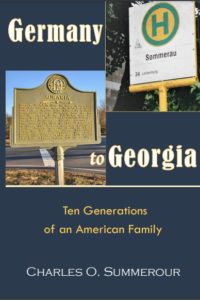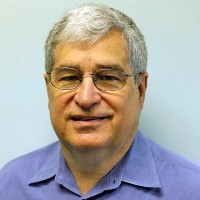By Elliott Brack
Editor and Publisher, GwinnettForum
JAN. 25, 2022 | Family history books can sometimes be boring for persons outside the immediate family.
![]() However, Charles Summerour of Duluth has completed a 10-generation study of his Summerour family that gives good insights into the life of North Georgia, particularly centered on what his family did in gold mining and in farming in the Johns Creek area. It’s a fast read, and keeps readers fascinated by his distinctive family members.
However, Charles Summerour of Duluth has completed a 10-generation study of his Summerour family that gives good insights into the life of North Georgia, particularly centered on what his family did in gold mining and in farming in the Johns Creek area. It’s a fast read, and keeps readers fascinated by his distinctive family members.
The family’s roots in Germany are from the Rhine-Palatinate area, particularly in the Trier-Saarburg District in Southwest Germany. The current population of their small town is only 75, with no Summerours living there now.
The first Summerours arrived in this country when it was still a British Colony, back in 1748, arriving in Philadelphia. This was a time when over 100,000 Germans would eventually migrate here, many settling in Pennsylvania. German language was routinely spoken in this area. Later the wider family would move to North Carolina, and still later to Georgia.
By the 1820s, Henry Summerour III (1787-1848) would be part of the Gold Rush in the Auraria area (a town that no longer exists in Lumpkin County.) Others of his family came to the area, and one of the Summerours opened a general store. The family was also active in the frenzy of gold mining, as were many people.
When gold was discovered in California in 1849, two brothers of the Summerour family set out for that area, settling in the Sacramento River area. Almost immediately, they found gold mining was bountiful. One brother wrote back: “(Gold) is so abundant that you can see it in the dirt.” After two years in California, one of the brothers returned, bringing with him a leather satchel that family history says contained 786 ounces of gold. That’s 50 pounds, “equivalent to $1.4 million today”, writes Charles.
That satchel of gold set up the Summerour family as among the richest in North Georgia. It also paved the way to what would be another major direction of the Summerour family: farming.
 The primary area of several Summerours in farming was in what is now the City of Johns Creek. The family centered around the Warsaw area, at Medlock Bridge Road and State Bridge Road. All total, a story in The Atlanta Constitution in 1964 described the Summerour lands as totaling 2,117 acres. It stretched from the Old Alabama Road to the Chattahoochee River, including the Atlanta Athletic Club.
The primary area of several Summerours in farming was in what is now the City of Johns Creek. The family centered around the Warsaw area, at Medlock Bridge Road and State Bridge Road. All total, a story in The Atlanta Constitution in 1964 described the Summerour lands as totaling 2,117 acres. It stretched from the Old Alabama Road to the Chattahoochee River, including the Atlanta Athletic Club.
Just after the turn of the century (1900s), one of the Summerours, Homer, began paying attention to his cotton stalks. Some of his cotton seemed to produce larger bolls than others, and he started collecting their seeds for re-planting. What resulted in a few years was a superior cotton seed, one with a 50 percent higher yield, called the “Summerour Half and Half” cotton seed. Unfortunately, Homer died in 1915, before he saw the experimentation come to completion. His son, Ben, took forward the idea, and successfully marketed the superior seed in wider parts. Ben also had a cotton gin later in Norcross, where he lived.
Meanwhile, other Summerours were active in the area, one farming in Gwinnett. Charles’s granddad started a tannery, which eventually became a leather manufacturing company complete with mail-order catalog (for dog collars, saddles, bridles, animal halters.)
Charles Summerour has written a fascinating book, entitled Germany to Georgia, about how one extended family has prospered and thrived in this area. It’s well worth reading, giving insights to this area. It is available online at Amazon for $19.99.
- Have a comment? Send to: elliott@brack.net











Follow Us